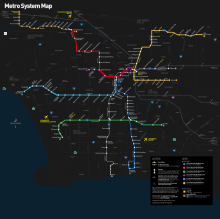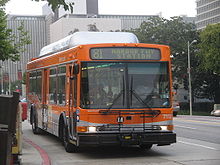Los Angeles Metro
| Los Angeles County Metropolitan Transportation Authority | |
|---|---|
 
|
|
| Basic information | |
| Company headquarters | Los Angeles County |
| Web presence | http://www.metro.net/ |
| Board | Phillip Washington |
| Employee | 9200 |
| Lines | |
| Gauge | 1435 mm ( standard gauge ) |
| Subway | 2 |
| Light rail | 4th |
| bus | 165 |
| number of vehicles | |
| Omnibuses | 2483 with contractual partners |
| statistics | |
| Passengers | 650 million (2012) |
| Residents in the catchment area |
9.82 million |
| Length of line network | |
| Bus routes | 2306 km |
The Los Angeles County Metropolitan Transportation Authority ( LACMTA or MTA ), commonly referred to as Metro Los Angeles , is the largest local transit company in Los Angeles County , California. With 9200 employees and a fleet of 2308 buses, it is one of the largest transportation companies in the United States .
history
The LACMTA was created in 1993 from a merger of the SCRTD ( Southern California Rapid Transit District ) and the LACTC ( Los Angeles County Transportation Commission ). The SCRTD has operated most of the mass transit traffic in the counties of Los Angeles , Orange , San Bernardino, and Riverside since the 1960s . The LACTC was founded in 1976 after a corresponding law forced every county in California to set up its own transport company. This led to competition between the two operations that culminated when the Blue Line, under construction (built by the LACTC) was supposed to run about 6 blocks away from 7th Street Station (built by the SCRTD), which was a possible link between the two would have prevented. After the LA Times reported on the incident, the boards of directors of both companies came under public pressure. Thereupon, on the initiative of Assemblyman Richard Katz, the merger of the two companies was decided. Both companies merged on April 1, 1993 to form the Los Angeles Metropolitan Transportation Authority ; This was not least welcomed by the SCRTD, as they had to contend with falling passenger numbers since the LACTC was founded.
train
The metro operates 6 railway lines, 4 of which are urban (Light Rail) and 2 underground lines (Heavy Rail). The total network is connected to 93 stations over a length of 98 mi = 158 km. Since 2013, the Metro has stopped offering paper tickets. A plastic card is therefore required for all train lines, the so-called TAP Card , which can be purchased at the ticket machine at all stations. A day pass for the entire metro network is $ 7 ($ 2.50 for retirees 62 and over) and a week pass is $ 25.
Light rail
- Blue Line (opened 1990) from Long Beach to Downtown LA . It runs partially underground in Downtown LA.
- Green Line (opened 1995) from Norwalk to Redondo Beach . One of the stations ( Aviation Blvd / LAX ) is near Los Angeles International Airport . From there there is a shuttle service to the airport.
- Gold Line (opened in 2003) from Downtown LA to Pasadena . 2016 to the Azusa .
- Expo Line (opened in 2012) from Culver City to Downtown LA. The first section is open, the second was opened on May 20, 2016 to the Santa Monica Pier .
Heavy rail
- Red Line (opened in 1993) from Downtown LA to North Hollywood . This line is by far the busiest on the metro. This line is very popular with tourists thanks to the stations Universal City directly at the Universal City Hollywood theme park , and Hollywood / Highland , near which the Walk of Fame , the Grauman's Chinese Theater , and the Grauman's Egyptian Theater are located.
- Purple Line (opened in 1993, expansion under construction since 2014) from Downtown LA and Mid-Wilshire District. It runs on the same route as the Red Line to Wilshire and Vermont station. From there it branches off and drives to two more stops.
bus
There are three different types of bus routes that can be identified by the colors of the buses of each type:
- Metro-local buses are the most common. They drive on most of the major roads and stop regularly (about every 200 meters). There are a total of around 16,000 bus stops on 189 lines. These buses are maintained in a orange, the Californian poppy is modeled (California Poppy), which is the state flower of California. California Poppy is also the name used by the metro for this color.
- Metro Rapid buses run on the main streets parallel to the local buses there. They only stop at the largest intersections and are therefore around 25% faster, according to the Metro. The buses are a fiery red color, which the Metro calls "Rapid Red".
- Metro Express buses stop very rarely and are mainly on the freeways (motorways). There are currently only 2 lines of this type (450 and 577). These buses are dark blue, referred to by the metro as "Business Blue".
All buses run on compressed natural gas , making the Metro the largest bus fleet of its kind in the United States.
Metro Liner
Metro Liner are bus lines that run as a replacement or as a preliminary operation of a light rail line (English: Bus Rapid Transit ). The Metro advertises them as “light rail on rubber tires”. The silver color is based on the color scheme of the light rail . These are two bus routes, some of which run on sections specially built for them and only used by them and are therefore much faster than the other metro buses.
- Orange Line (opened in 2005, extended in 2012) between North Hollywood and Woodland Hills . This begins at the North Hollywood terminus of the Red Line, and stops about once every two kilometers.
- Silver Line (opened in 2009) between El Monte and San Pedro . It runs mostly on the El Monte Busway and the Harbor Transitway and rarely stops in between.
literature
- Hans-Ulrich Rindel: Metro and light rail in Los Angeles . In: City traffic . tape 69 , no. 5 , May 2020, ISSN 0038-9013 , ZDB -ID 242252-9 , p. 32-42 .
Web links
Individual evidence
- ↑ https://www.sanfrancisco4you.com/los-angeles/oeffentlicher-nahverkehr.html
- ↑ http://www.metro.net/projects/expo-santa-monica/
- ↑ http://www.metro.net/news/facts-glance/#P1_17
- ↑ http://media.metro.net/images/service_changes_transit_service_policy.pdf
- ↑ http://media.metro.net/about_us/govtrela/images/CNG_Factsheet_2010.pdf
- ↑ http://thesource.metro.net/2012/05/31/whats-happening-at-other-transit-agencies-30/




